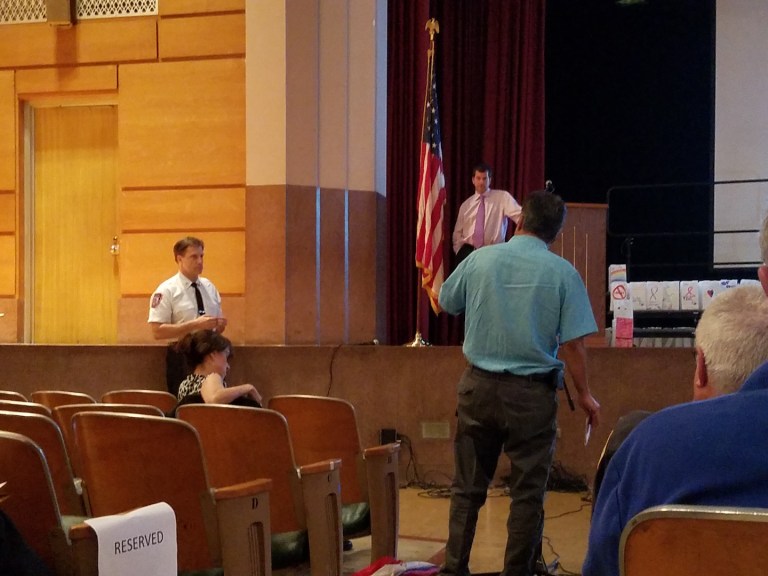
The idea of billing for EMS services came under fire at an information session hosted by Vigilant Fire Company on a stormy Monday night, with residents saying they failed to see the point.
David Weiss, chairman of Vigilant Fire Company’s board of trustees, said this has been a topic for at least 15 years. However, this year is different in that the company is openly investigating billing at the request of local mayors.
But many residents present expressed concern over the impact that billing for emergency medical services could have on both the community and fire company.
Currently, several villages jointly contract with Vigilant Fire Company for ambulance services and do not bill the insurance companies. Switching to EMS billing would require Vigilant Fire Company to split into two distinct legal entities to be in compliance with state law.
This process would take around a year.
The information session, featuring EMS billing expert Bradley Pinsky, was a means to make sure residents were involved in the conversation.
Adam Harel, a candidate for Great Neck Village’s Board of Trustees, expressed concern that people might not call for help for fear of not being covered. Some also said that billing could damage the personal nature of interactions with the fire company and add time filling out paperwork.
Jean Pierce, another concerned resident, said that she appreciated the information session as a means of preventing mayors from making such a major decision for residents.
“Yes, they have a duty to ensure that things run smoothly and with the government,” Pierce said. “But it is ultimately the residents who must make decisions of what is best for them.”
A few mayors were in attendance, including Kensington Mayor Susan Lopatkin, Saddle Rock Mayor Dan Levy and Great Neck Plaza Mayor Jean Celender. All of them praised the service Vigilant Fire Company provided.
Levy arguably made the most forceful case favoring billing for EMS service, suggesting that charging the insurance companies will reduce ambulance expenses for the village by “25 or more percent.” Great Neck villages collectively pay about $1 million a year toward the ambulance contract.
“That’s the idea. We can get more services, better or more equipment, more paid paramedics or we can even get better response and ultimately we get better service to our residents with less money, less out of pocket,” Levy said. “We cannot lessen their medical insurance bill, but we could lessen their tax bill.”
Levy also said that villages would still, in effect, be paying for some services because they would pick up the remainder of the tab that insurance companies wouldn’t pay.
Elizabeth Allen, a concerned resident, contested the idea that the switch could lower costs and said there would be hidden costs.
“That seems to be the magic formula that politicians get away with for justifying things that are otherwise inexplicable, so I again say: ‘Why are we here? What forced us to this point?'” Allen said. “I don’t see a single resident wanting this.”
The call for a switch in billing comes as Vigilant Fire Company faces increasing numbers of medical calls. There were around 700 medical calls per year in the 1990s, according to Vigilant Fire Chief Joshua Forst. Last year, the fire company answered 1,965 medical calls, averaging six per day.
Villages, meanwhile, face increased financial pressure imposed by the state tax cap. Mayors have argued that investigating alternative billing arrangements to recoup costs is necessary to maintain other services.
The Villages of Great Neck, Kings Point and Great Neck Plaza pay the most for ambulance services. Great Neck pays $260,421, Kings Point $215,982, and Great Neck Plaza $125,637.
Pinsky, who helped many fire departments switch over to billing for EMS service, said that there aren’t often any issues so long as there is a clear purpose for it.
Pinsky also said that forums hosted by fire companies were not common.
“To get to the residents this early [about EMS billing] is very uncommon to my clients,” Pinsky said, noting he has represented around 500 fire departments. “This is a really great decision on their part. It’s symbolic of the community they live in.”







To facilitate the seamless encoding and billing process, the encoder checks the patient’s medical record (Transcription of doctor’s records, ordered lab tests, requested image studies, and other sources) to verify the work performed. Anesthesiologist coding read the patient’s medical record and analyze it, determining the patient’s diagnoses and any procedures performed.